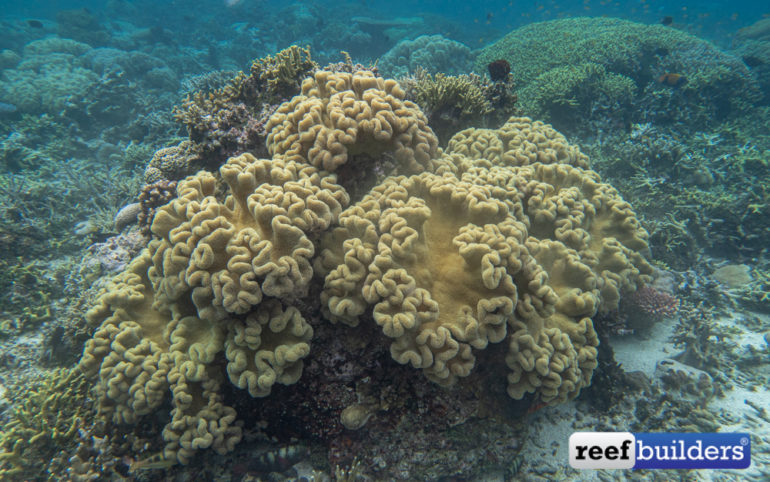In our previous review of octocoral classification, we saw that anywhere from 3–8 orders have traditionally been used to organize this group’s bewildering biodiversity, based on morphological assumptions of increasing complexity within the evolutionary history of these corals. It was sensible to assume a scenario wherein a species with solitary polyps (Protoalcyonaria) would belong to the earliest lineage, advancing on to stoloniferous species (Stolonifera), and then the Soft Corals (Alcyonacea) and Gorgonians (Scleraxonia, Holaxonia, Calcaxonia), perhaps finally culminating in the Sea Pens (Pennatulacea).
But this differs vastly from the picture painted by their molecular data. By utilizing a mix of nuclear genomes in combination with a broader taxonomic coverage via the mtMutS mitochondrial gene (equivalent to the CO1 “barcode gene” used in the analysis of other animals), McFadden, van Ofwegen, & Quattrini 2022 has for the first time established a well-supported phylogeny encompassing most of the previously recognized families (55 of 63). This has enabled an extensive reclassification for Octocorallia, resulting in a remarkable 21 (twenty-one!) new families, plus a complete reorganization of the higher-level taxa. The scope of these changes is something rarely seen in modern biology and speaks to just how wrong the historical taxonomy had been in sorting out these corals.

In place of that old system of confusing and sometimes ambiguous orders, we now have just 2 major clades that are given this rank, Malacalcyonacea and Scleralcyonacea. These rather unwieldy names derive from the Greek malacos (“soft”) and scler (“hard”) and give some hint at the groups contained therein. Amongst the malacalcyonaceans we find most of the Soft Corals and Holaxonia Gorgonians, along with the only examined protoalcyonarian (Taiaroa tauhou) and the various stoloniferan genera. Scleralcyonacea is composed of nearly all of the Calcaxonia Gorgonians, some of the Scleraxonia Gorgonians, the Blue Corals, the Sea Pens, plus a few Soft Corals with comparatively stiff colonies. Importantly, there is no single morphological trait or suite of traits that define these groups, as the octocorals still refuse to be easily defined.
Additionally, the higher-level classification of their phylum, Cnidaria, has received a bit of a shake-up, though whether such nomenclatural changes become widely adopted by the broader taxonomic community remains to be seen. A pair of new subphyla are established, Medusozoa and Anthozoa, the latter including all of the corals and coral-like groups, while the former includes jellies and hydroids. Within Anthozoa, we find Octocorallia and Hexacorallia elevated to class rank, whereas these had previously been treated as subclasses of the class Anthozoa. Of course, this is mostly semantics and doesn’t reflect any change in our understanding of the relationships of these groups, but it does better indicate their ancient evolutionary histories, whose origins likely date to the Precambrian (as explored in McFadden et al 2021).
Now let’s familiarize ourselves with some of the family-level taxonomic changes that have occurred, starting with the Malacalcyonacea. This is the group that includes corals most familiar to aquarists, and we’ll focus our attention on these in particular.
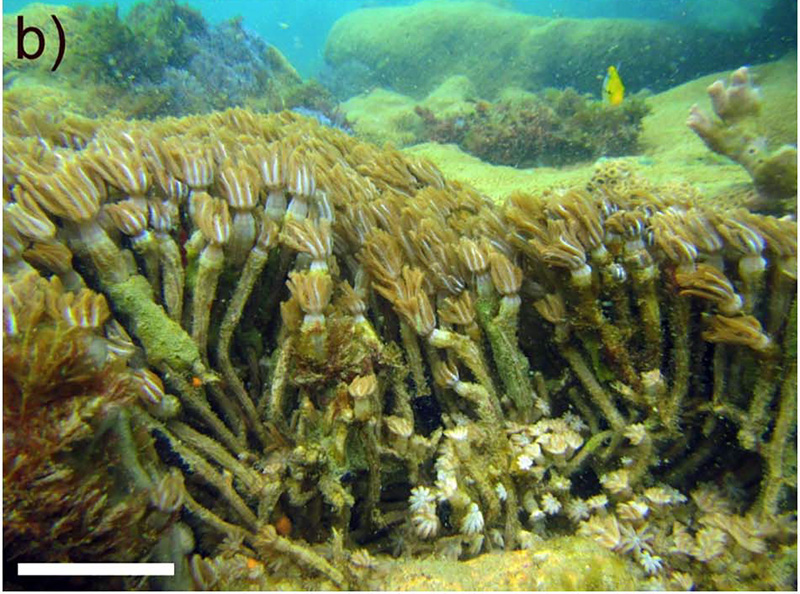
Clavulariidae
This family has historically been a dumping ground for just about any stoloniferous octocoral that couldn’t be fit elsewhere, and, not surprisingly, the molecular data found it to be highly artificial. In its new svelte format, the clavulariids sits as a basal lineage within Malacalcyonacea and now includes just 3 genera: Clavularia Clove Polyps, Knopia Daisy or Jasmine Polyps, & Hanabira (a West Pacific genus described in 2019, absent from the aquarium trade). There is still a ton of work to be done within Clavularia, which includes dozens of nominal species whose relation to the type species, C. viridis, remain untested.
Acrossotidae, Arulidae, Tubiporidae
Like the clavulariids, these families include stoloniferous species and lump together as another early lineage within their order, suggesting that the ancestral malacalyconacean bodyplan may have been of this relatively simple form. The acrossotids are noteworthy for their complete absence of sclerites (a rare trait amongst octocorals); Acrossota and Phenganax are both common hitchhikers (and borderline pests) in aquariums. In contrast, Arulids are well-protected by a dense covering of flattened sclerites (“table radiates”); these comprise a small but widespread group that is rarely seen in captivity (though I once had a small colony arrive on a Balinese coral). Tubiporids are the most diverse of these families, both in terms of species number and ecology. Herein we find the familiar Tubipora Organ Pipe Corals, as well as the less familiar reef-associated Paratelesto, along with several poorly known genera from deeper habitats. The presence of red sclerites, usually fused into a rigid skeleton, is a noteworthy feature of the family.
Melithaeidae
The melithaeid gorgonians are a predominantly reef-associated family that has been expanded with a few genera (formerly included within Anthothelidae) and represents one of the major clades utilizing the scleraxonian bodyplan. As most of these are azooxanthellate, specimens are rarely available to aquarists, but they are often abundant in the wild—Melithaea ochracea in particular is one of the most prominent large gorgonians throughout much of the Indo-Pacific. The peculiar Gutter Gorgonians (Solenocaulon, Iciligorgia) also fit here, having previously been regarded as a sort of proto-gorgonian due to their partially open branches. The little-known genus Alertigorgia is a West Pacific native whose species are atypically zooxanthellate, thus one of the few Indo-Pacific gorgonians suitable for captivity (though specimens are seemingly never collected).
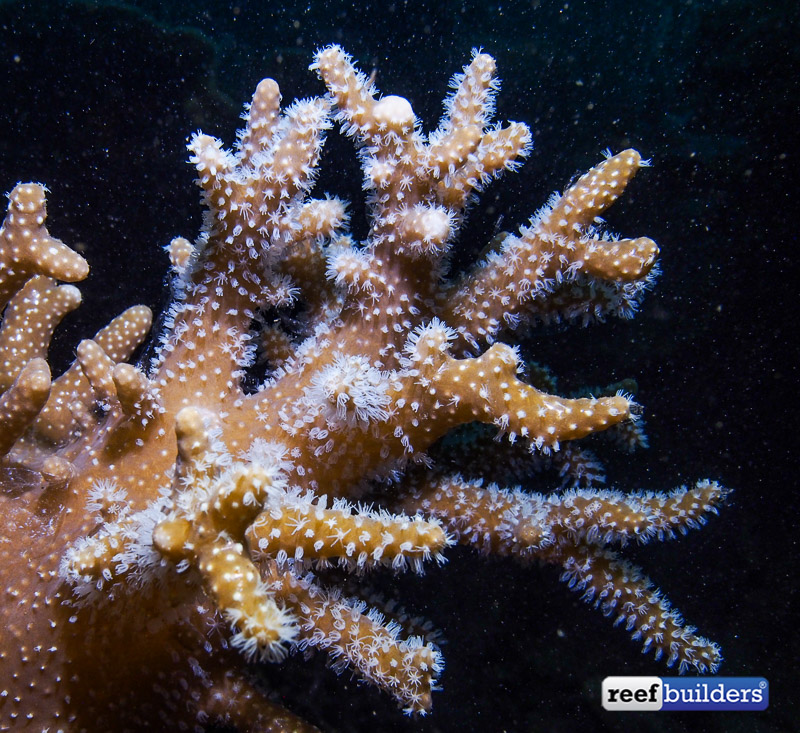
Siphonogorgiidae
This small family (comprising only 2 genera: Siphonogorgia, Chironephthya) is ubiquitous on Indo-Pacific reefs, especially in areas with strong currents, but these azooxanthellate and often vibrantly colored gorgonian-like Soft Corals are mostly unsuitable to aquarium life. These had formerly been lumped within Nidaliidae based on having similarly rigid colonies.
Alcyoniidae
Similar to the clavulariids, this family long served as a convenient place to classify generic-looking soft corals, thus it slowly ballooned to include dozens of genera from every ecosystem imaginable, including familiar friends like Sarcophyon, Sinularia, and Klyxum (we’ll get to those shortly). In its new iteration, alcyoniids are a predominantly temperate group that is loosely defined by nuances of their sclerite composition and arrangement. Included here are species that range in shape from membranous to lobate to arborescent; remarkably, these various forms can sometimes occur within a single species, as in the protean Anthothela grandiflora.
Carijoidae
The former Telestacea, an order of stoloniferous octocorals with long axial polyps, is no longer recognized, with its constituent genera scattered throughout this new classification. The most familiar of these is Carijoa, a common biofouling coral throughout the tropics and subtropics. Oddly, a small encrusting coral from California, Cryptophyton goddardi, is also included in this family, though there are no clear traits uniting these morpholigcally disparate genera. Whether this is an artifact of the molecular analysis or indicative of their true evolutionary origins warrants further scrutiny.
Sarcophytidae
For aquarists, this is probably the most noteworthy change, as the sarcophytids are a new family home to some of the most commonly traded Soft Corals. Here we find the Sarcophyton Toadstool Corals, the Lobophytum Devil’s Hand Corals, and the Sclerophytum Finger Corals. If that last name doesn’t ring any bells, it’s probably because it hasn’t been used much since being described in 1903, but it now includes most of the species formerly considered to belong to Sinularia—no doubt this will be a taxonomic change hard to swallow for many. The sarcophytids are an Indo-Pacific family of zooxanthellate reef species, with club-shaped surface sclerites and often with siphonozooids (absent only in Sclerophytum).
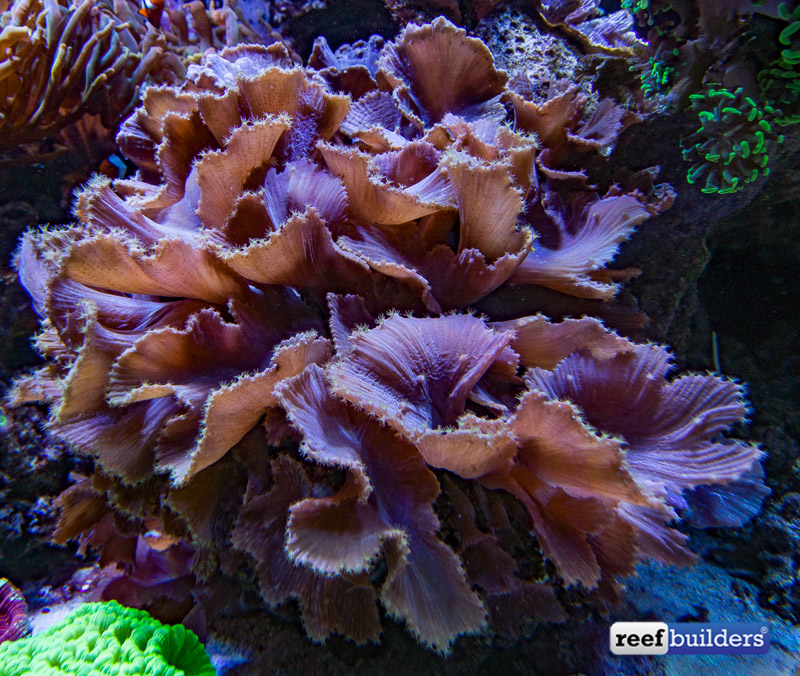
Nephthyigorgiidae & Sinulariidae
The Nephthyigorgia Chili Corals have gotten their own family, having formerly been considered alongside the siphonogorgiids and nidaliids owing to their similarly rigid colonies. Their closest relative are apparently the Sinularia Cabbage Corals, a genus now whittled down to only include its type species, S. brassica (and possibly some similar species, like S. dura, though the species level diversity of this group is still unsettled). Like its former congeners in Sclerophytum, Sinularia has large, fleshy colonies without siphonozooids and with large spindle-shaped sclerites in the interior. Where these differ is in the precise shape of the surface sclerites, which in Sinularia are described as being toothy clubs, plus the addition of small scale-like sclerites in the tentacles. These are the kind of minor differences that were easy to overlook by earlier generations of taxonomists, revealed only through the light of molecular investigation.
Capnellidae
Yet another new Soft Coral family is the Capnellidae, split off from the Nephtheidae, from which it differs by the absence of a supporting sclerite bundle beneath its polyps, along with subtle differences in its precise sclerite composition. This group includes a broad geographic and ecological range of species, from polar to the tropics and into the deep sea, and will be familiar to aquarists only on account of the type genus, Capnella. This oft-misidentified genus is generally uncommon throughout the Indo-Pacific and may be recognized by its non-retractile polyps and an alabaster coating of small surface sclerites.
Nephtheidae
This long-standing family has seen some substantial subtraction in the new classification, losing species to Capnellidae and Lemnaliidae, both of which lack the supporting bundle of sclerites (best seen in the prickly “thorns” of Dendronephthya) that now defines the group. These Indo-Pacific corals are largely azooxanthellate, but the Litophyton Kenya Trees and Neospongodes (a newly recognized senior synonym of Stereonephthya, btw) are exceptions, the latter being an introduction into the West Atlantic, presumably via international shipping. The commonly available azooxanthellate species in Dendronephthya and Scleronephthya are probably most familiar to aquarists for slowly dying in their tanks.
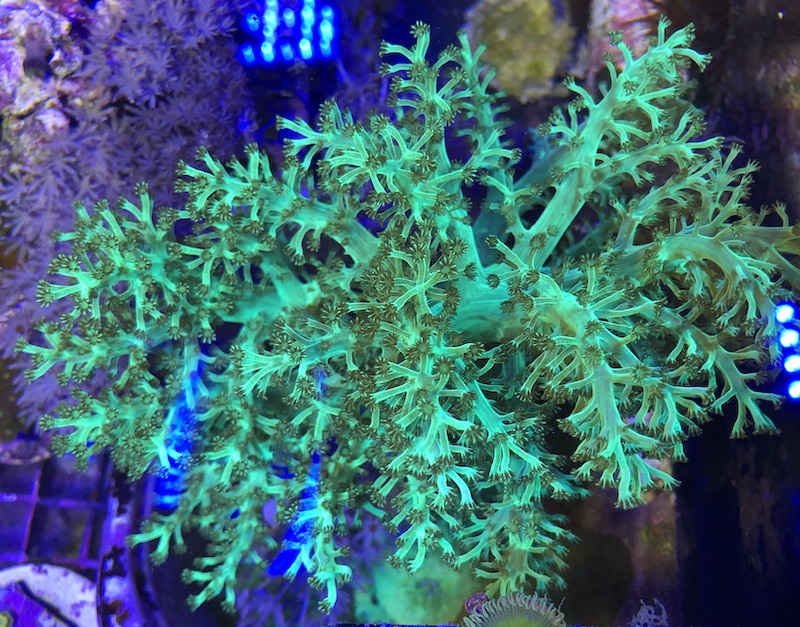
Cladiellidae & Lemnaliidae
These former nephtheids are now rightfully removed into their own families, which should hopefully help us to appreciate the significant morphological discrepancies that separate them. The cladiellids Cladiella and Klyxum are variably known as Blushing Corals or Colt Corals, the former name alluding to the strongly contractile (but not truly retractile) polyps that reveals the pale coenenchyme of the colony, while the latter name is complete nonsense and should be utterly abolished, right? Thanks, glad we agreed on that. The sclerites of these vary from double-heads (Cladiella) to blunt spindles (Klyxum). In contrast, the lemnaliids have more delicate stick-like sclerites throughout the colony. This small group includes arborescent species (Lemnalia), digitate species (Paralemnalia), and encrusting species (Rhytisma), all common in the Indo-Pacific. The latter genus is an objectively interesting coral, often brightly yellow in color, and is deserving of far more appreciation from aquarists.
Coelogorgiidae & Xeniidae
Coelogorgia palmosa is an intriguing zooxanthellate Soft Coral from the Indo-Pacific; its preference for outer reef slopes exposed to strong flow presumably explains its absence from the aquarium trade. Like Carijoa, there is a prominent axial polyp that develops from a network of stolons, but these go on to develop attractive sidebranches, resulting in relatively large, bushy colonies. Though it looks nothing like a xeniid, molecular data places it as the sister group of that family. Speaking of, the xeniids have long been one of the few well-defined Soft Coral families, thanks to their distinctive corpuscular sclerites, weakly retractile polyps, and some peculiarities of their mesenteries. Of note to aquarists will be the Pulse Corals (Xenia, Heteroxenia, Unomia), the Anthelia Waving Hand Corals, and Conglomeratusclera coerulea, usually misnamed as Cespitularia. Sympodium also occurs here, though you’re more apt to see that name misused for unrelated aquarium species (but we’ll cover that in a future installment of this series). There’s also the dreaded and beautiful aquarium pest Sarcothelia. The only major change is the addition of an obscure Indo-Pacific genus, Protodendron, whose armature of sclerites is more like that of the closely related families Lemnaliidae and Coelogorgiidae.
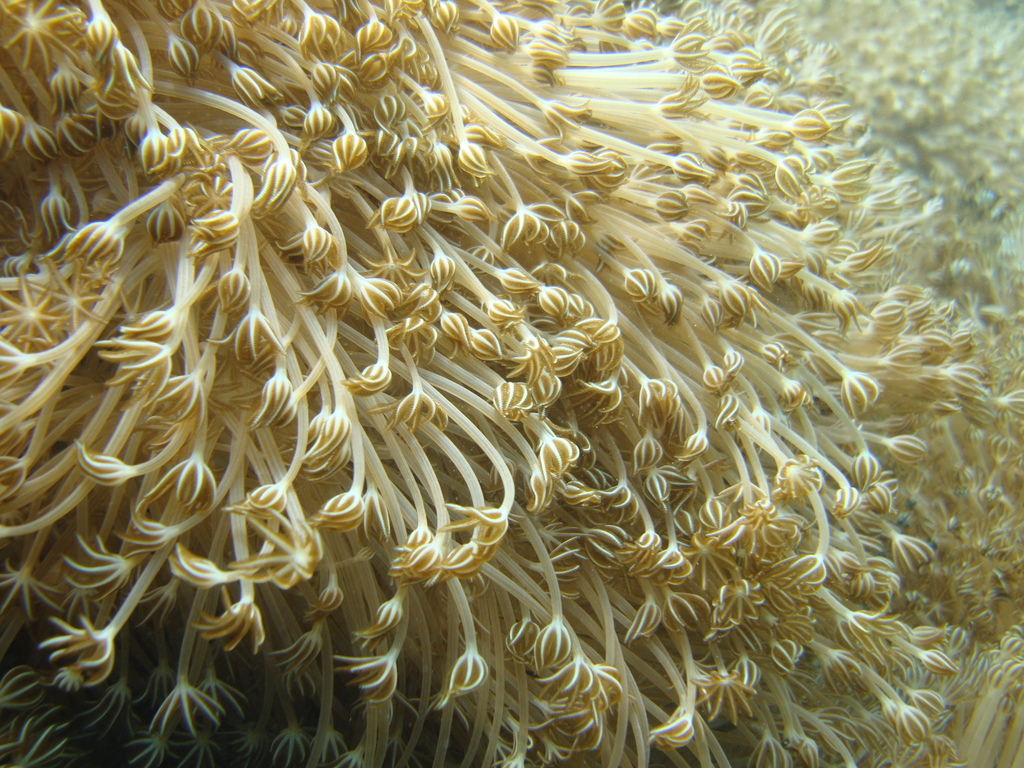
Now, I should add that we’ve skipped over a great many small, but interesting, families thus far, especially those with non-tropical distributions. South Africa is in particular a gold mine of unique endemic families, for those interested. The remainder of the Malacalcyonacea is mostly former gorgonians of the Holaxonia, and we’ll explore that next time.
About the author
Joe Rowlett is the author of Indo-Pacific Corals and studies marine biogeography and speciation. He is a former aquarist and has written extensively for aquarium publications.


